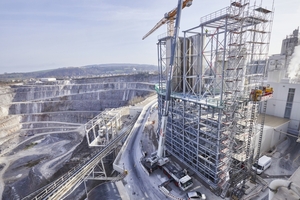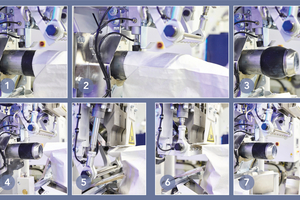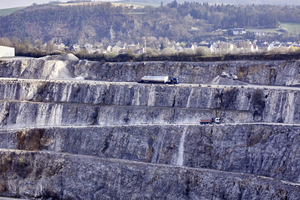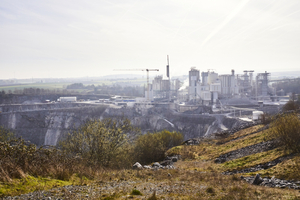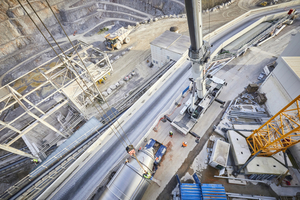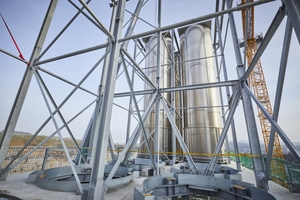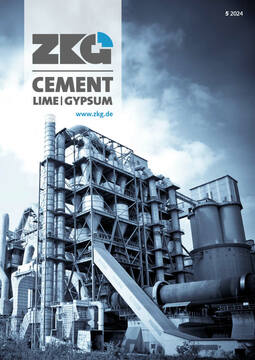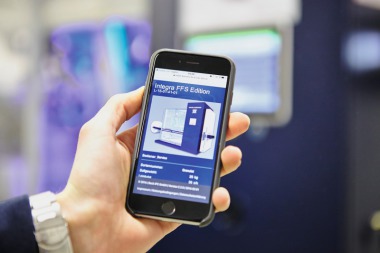Building on the precipice: New construction on the edge of a quarry
Iron and steel, building materials, PVC, paper - these are items we use every day, and usually without thinking about how many people and which resources have contributed to their production. One common ingredient is the raw material lime. As an indispensable all-rounder, it is used in countless sectors of the economy and makes an important contribution to environmental protection. The German family-run company SCHAEFER KALK in Hahnstätten, Rhineland-Palatinate, has been mining lime for more than 160 years. Together with HAVER & BOECKER, SCHAEFER KALK is now taking a major step towards resource conservation and sustainability.
In a very special construction project, the Hahnstätten lime plant is undergoing expansion to include a new packing complex for efficient, clean and therefore resource-saving packing of the universally applicable precipitated calcium carbonate (PCC) specialty product, which is produced synthetically on the basis of lime - all in a very confined space.
1 Company and project descriptions
SCHAEFER KALK: bedrock for reliable supply
The SCHAEFER KALK quarry Laybruch in Hahnstätten covers an area of 800 x 900 meters. At 24 meters above sea level, the floor is the lowest point in the German state of Rhineland-Palatinate. The sight is overwhelming and the huge dump trucks and loaders look like toy cars from above. It is one of the purest limestone deposits on earth. SCHAEFER KALK mines high-quality raw materials for the construction, iron, steel, paint, plastics, paper, food and pharmaceutical industries. With its two business areas of lime and PCC SCHAEFER KALK serves a wide range of national and international customer needs and thus secures the supply of one of the most important raw materials in our society.
SCHAEFER KALK: responsibility for the future
SCHAEFER KALK is aware of its responsibility. The aim is to meet the demand for lime and PCC while protecting resources in the best possible way. With this in mind, the company is now investing in a new PCC packing and storage logistics system. It has a strong partner at its side in the family-run company HAVER & BOECKER from Oelde. The major project includes the expansion of the existing PCC production facility to include a new silo and packing system.
2 Lime & PCC
PCC: precipitated calcium carbonate as an innovative all-rounder
Precipitated calcium carbonate, PCC for short, is used wherever high chemical purity, perfect white pigmentation, high opacity, best possible fineness, narrow particle size distribution or precisely defined crystal structures are essential for getting a perfect result.
To produce PCC, carbon dioxide gas is introduced into milk of lime. This produces an aqueous suspension, which is filtered, dried and ground, according to the desired end product. Depending on the type of reactor and how the process is carried out, different crystal structures, particle shapes and sizes develop. These minute changes make possible an almost unmanageable range of products.
PCC differs in its properties from naturally occurring calcium carbonate. It is used as a filler in tablets, as a calcium component in foods and food supplements, an auxiliary material in paper and plastics production or as a white pigment extender in emulsion paints.
SCHAEFER KALK has developed into the quality market leader for special PCC and today supports customers worldwide in the ongoing development of their products or product innovations through its own.
Multitalented lime
Building construction
Limestone is used throughout the construction industry. In road construction it provides a stable base, as an aggregate in concrete it ensures a particularly long service life, in fluffy aerated concrete blocks it contributes to excellent thermal insulation, and when used as sand-lime bricks it provides outstanding soundproofing properties.
Iron and steel industries
Iron and steel production is not possible without lime. In order to obtain iron or steel, impurities are removed using lime in various processing and reaction steps. This requires lime of a very high quality.
Pharmacy & medicine
Lime is an important raw material for the pharmaceutical industry. It is used as an auxiliary tabletting agent, acid regulator or calcium supplier. Dentists, for example, also use lime indirectly to make plaster casts.
Cosmetics
Whether toothpaste or peeling - lime ensures cleanliness as a cleaning agent and is used in many cosmetic products such as powders.
Paper
The addition, PCC gives paper a special whiteness and opacity. It also increases the volume and improves printability.
Agriculture
Lime is indispensable for the fertility of soils as the balanced lime content, in addition to the humus content, contributes significantly to the success of cultivation. As growing plants extract lime from the soil, acidic soils are neutralized by lime and lime promotes humus production. Thus regular liming of agricultural land has been practiced for centuries.
Food & beverages
Beer and wine are produced with lime, as is citric acid, which is used in soft drinks. Lime is indispensable in the sugar industry. Because only with lime can the non-sugar substances, such as proteins, be extracted from the sugar source (e.g. sugar beet) and filtered out.
Environmental protection
Water, air and soil are the three components of our biosphere. Lime is actively used for environmental protection in all three areas. For example, it plays a decisive role in energy production and flue gas purification in waste incineration and binds harmful substances. Forests damaged by air pollution are treated with lime to raise the pH value. This can increase tree resilience and thus also improve our air. Healthy forest soils are also crucial for the quality of drinking water, which is often extracted from the soils of large forest areas. In order to turn this groundwater into healthy drinking water, lime is used to purify it of secondary constituents such as iron and manganese and to upgrade it through softening, hardening or neutralization. Wastewater is treated with lime and can be returned to rivers and lakes after intensive purification.
3 Packing
PCC: sophisticated product for demanding applications
Due to its variable crystal structure, PCC is convincing for countless areas of application. However, this changeable structure and the bulk behavior of the product also pose challenges for producers like SCHAEFER KALK. Storage and logistics require packaging that is robust and protects the product and the environment. This is where the expertise of the Westphalian plant manufacturer HAVER & BOECKER comes into play.
“PCC is a powdery product. It is best compared to flour, which is very fluffy,” says Dr. Kai Schaefer, Managing Director at SCHAEFER KALK, describing the precipitated calcium carbonate. “Together with SCHAEFER KALK, its inhouse laboratory staff and our HAVER & BOECKER Institute, we took a close look at the product and its properties. Here in Oelde, we have the opportunity to carry out filling trials with the planned packing technology and see which machine and which bag are suited to the product,” explains Don Dörner, engineer at HAVER & BOECKER and one of the project managers for this building project. During these tests and further discussions with experienced sales people from SCHAEFER KALK, the paper bag with SEAL valve for secure closure was identified as the optimum packaging. Thanks to its special design, it allows the product to be vented beyond the filling process, but is tight enough to prevent product particles from escaping. The prefabricated valve bags are filled without loss and to the exact weight before the valve is ultrasonically sealed using the SEAL technology. The bags therefore meet all the requirements for hygienically demanding sectors like food production and the pharmaceutical industry. For larger containers, the PCC will be filled into big bags in the future and sealed without loss.
Packing: clean valve-bag filling thanks to SEAL
The SEAL technology for valve bags enables clean filling into paper and composite bags. A sleeve inflates in the specially designed filling spout at the start of the filling process, thus sealing the valve bag so that no bulk material escapes. After filling, the bag valve is ultrasonically sealed shut.
This filling method leads to a clean work environment and improved health standards for all plant employees. This will also be the case in the future at SCHAEFER KALK in Hahnstätten. In addition, the filling method creates a compact and completely closed bag, thus ensuring clean handling throughout the logistics chain and finally on the customer‘s premises.
Another important point is increased process reliability, which can be attributed to clean filling. Less dust means a significant reduction in wear and tear on the entire system periphery, which leads to more machine operational availability, less production downtime due to cleaning, less maintenance, reduced repair works, lower operating costs and consistently high capacity utilization.
In addition to cleanliness, safety plays an important role. The ultrasonically sealed, secure packaging protects the environment from possible contamination and promotes safety at all points along the logistics process. At SCHAEFER KALK, it also protects the packaged high-quality PCC from contamination and removal.
A clean and attractive bag appearance creates a positive impact on the company and product image and so makes it stand out to the end customer.
The SEAL technology can be retrofitted to all existing HAVER & BOECKER packers for valve bags purchased after the year 2000.
4 Construction project / machines
Construction project: aiming high at the very bottom
The 350 million year-old Devonian limestone lies hidden under a layer of earth and clay at the Hahnstätten site. It is a good and stable soil on which to build a plant with silo facilities. An absolute dream location for construction planners and plant engineers like HAVER & BOECKER - were it not for two spatial conditions that make the entire undertaking tricky: limited building space due to the existing periphery and the 160 meter deep limestone quarry with the typical steep slope.
The Hahnstätten lime works of the SCHAEFER KALK company has been in existence for 160 years. During this time, the face of the quarrying site directly on highway B54 between Hahnstätten and Limburg has changed steadily, and so has the PCC plant. It includes various production lines with precipitation reactors, filtration and drying as well as the logistics area with packing and loading.
Increased demands on product quality, hygiene and storage have to be met and resources must be conserved and protected in the best possible way. The safety and health protection of employees must also be constantly improved. As a result, the initial idea of only replacing individual machines in the existing packing line turned into a unique, large-scale project, a project for the future.
Unique location with a special challenge
Anyone approaching the lime works via highway B54 from Limburg to Hahnstätten will certainly be taken aback the first time they see it.
The quarry Laybruch, which covers almost one square kilometer, is surrounded by fields and meadows. The plant with its kilns and silos is located to the south behind it. It is 55 m from the outermost edge of the PCC production hall in front to the first steep slope of the quarry, with each meter being crucial for the hall’s expansion. In its current form, it is not large enough to accommodate the future packing of PCC products with bagging silos and a packing line. This project therefore has a small area with the greatest demands and high logistical requirements for conversion, all the while being in operation.
Communication and concepts put to the test
Five years of planning have been carried out by the teams. The team at HAVER & BOECKER spent two years planning, calculating, analyzing and carrying out feasibility studies with experienced civil engineers and 3D scans on site. At the same time, professionals in other departments planned which machines and systems would be best for the project. Next they entered the active phase with construction drawings, flow charts and estimates for external services.
“It was complex,” summarizes Dörner. “There were more new points to consider than in any of our projects before - and we have already realized many with special requirements.” The 32-year-old engineer has been with HAVER & BOECKER for 15 years and has been involved in a number of them during his apprenticeship, studies and employment. “The construction of the new hall is a highly complex matter, not only because of the limited available space, but also because production cannot be shut down during the 15-month building period. We will therefore be constructing the new building right in the middle of ongoing operations,” explains Bernd Pösentrup, Head of Commercial Project Management at HAVER & BOECKER. The plan is to dismantle part of the old hall and build the new hall around it. “Then we will set up and install the machines and systems piece by piece. Only when everything is up and running will the rest of the inventory be dismantled or adapted to the new processes,” says Pösentrup, who emphasizes that this is only possible thanks to the absolute teamwork of everyone involved and an organized shift work model. The focus here is therefore not only on coordination, but also on the cooperation of highly motivated teams with a wide variety of specializations. “The SCHAEFER KALK employees and the HAVER & BOECKER construction team have to work hand in hand. Keeping an eye on each other and looking out for each other‘s safety is immensely important, because everyone has their own fixed work processes which are influenced by these two parallel work areas. Deliveries for the job site must not hinder the logistics and nobody is allowed to place pallets where a wall is to be built. But we are sure that these teams will also grow together in the coming months,” says Pösentrup, smiling, reflecting on the already very collegial communication of the past few years.
Foundation meets bedrock
After five years of planning, the long-awaited ground-breaking ceremony took place in July 2023. Completion is scheduled for fall 2024. At the start of the project, the focus was on stability. Thirty concrete bases with a diameter of 60 to 90 cm have already been poured 15 m deep into the ground as piles to secure the building. This is followed by the construction of the hall, pipelines and silo systems, which are up to 40 meters high. Six aluminum silos with a volume of 200 m³, plus two reserve spaces for future expansion, and four smaller silos with a volume of 75 m³ will be used to store PCC with various crystal structures. In these silos, the PCC will be deaerated by sedimentation and fed from there into three HAVER & BOECKER packers, depending on requirements and customer application.
Bundled expertise from the entire sector
Due to the product properties and use in the pharmaceutical and food industries, only aluminum silos were an option. “Aluminum silos are not our specialty. But here we were able to fall back on the product range of a longtime partner company. It was important to us that the project was a perfect fit for the customer and the product PCC. We also drew on the expertise of our technology subsidiaries, partners and competitors for other plants in order to deliver the best possible result for our customer. We have used the best of the best. You can‘t and don‘t have to do everything on your own. In the end, the overall solution is what counts for us,“ summarizes Hegemann, Head of Automation Engineering Packing Technology.
Everything in sync
The heart of the entire packing system will be the HAVER & BOECKER INTEGRA® and ELEMENTRA® EGF filling systems, which will set the speed for the ultra-modern packing lines. The fully enclosed INTEGRA® system with 4 filling spouts will be used to fill powdery, floury and granular products into valve bags, and hygienically sealed inside a dust-encapsulated housing. To further protect the product, the bag valves are sealed shut after the filling process using the SEAL technology. With the INTEGRA®, SCHAEFER KALK will fill the PCC in paper valve bags, each with a weight of 25 kg. Two ELEMENTRA® EGF filling machines will be set up for larger quantities. These Big Bag filling stations will fill the PCC in large containers from 500 kg to 1.5 tons.
Highly sensitive check-weighers were planned in order to fill the very light PCC accurately by weight. A metal separator and a foreign body sieve will ensure appropriate product purity and safety. In addition, HAVER & BOECKER will install the strongest filter system with the lowest amount of residual dust in its history.
“With our packing machines, we will set the rhythm at which the PCC products are packed,”explains Dörner. “This cycle is picked up by the downstream, largely automated peripherals, i.e. palletizing and others. As a result, the entire process will run more smoothly and evenly. We achieve resource-savings on several levels, namely through the loss-free filling of the product itself, but also with regard to efficient processes, reduced wear and tear, and less physical strain on employees. Automation does not primarily replace people at this point, but makes their day-to-day work easier. They can be deployed more qualitatively, devote themselves to more important tasks and exert less effort,” says Dörner, explaining another advantage of the new systems.
Automation and digitalization for better work conditions
As an automation and digitalization expert, HAVER & BOECKER is familiar with the concerns that arise among the workforce when it comes to modernization. There is often a fear that workers will become redundant. “We have found that although employees‘ tasks are changing, they can and must continue to contribute their energy. Automation and digitalization simplify work processes. Where pallets used to be shrink-wrapped manually, this is now done by a machine - operated by a person. For the employees, automation therefore means they are taken out of the active danger zones and can expand their tasks and skills as machine operators. Instead of inserting thousands of bags every day or moving hundreds of pallets around, they can supervise the function of the system, which is a huge relief in their day-to-day work,” explains Dr. Schaefer.
After the conversion, SCHAEFER KALK will be able to pack more than 20 tons of precipitated calcium carbonate (PCC) per hour and stock it for transport. The immense reduction in noise and dust, the increased occupational safety, improved work conditions and increased product quality represent a quantum leap in efficiency and quality. For SCHAEFER KALK, this means securing its market advantage with convincing packaging-assured product quality, maintaining its role as a supplier of special PCC, and enhancing its status as a regional employer in Hahnstätten. Moreover, the quality of the precipitated calcium carbonate and its filling will be secured in the long term and independently for all requirements of the German market.
5 Cleanliness and security
Clean processes for reduced operating costs
Dust negatively impacts machines and associated equipment. Its influence may not be noticeable at first, but over time it penetrates deep into machines and systems. The fine particles increase wear due to friction or their chemical effect on the oils, greases or the plastics used. This results in reduced machine performance or breakdowns, which in the worst case can lead to longer-term production downtimes. “We are taking precautions here. Many system components are already shielded by a housing and the entire system is enclosed. We have also perfected clean filling,” explains Pösentrup. The reduced wear is noticeable through the more efficient processes. The machines run reliably with less downtime for maintenance, diagnostics and repairs. The reduced need to replace parts or complete systems minimizes stoppages and lowers costs for repairs and spare parts.
Resource conservation
“Resource conservation concerns us all, which means that each of us is part of a long chain. HAVER & BOECKER also considers these consequences in order to achieve holistic positive effects,” says Florian Festge, Managing Partner at HAVER & BOECKER. “Our aim is to protect human habitats and use the planet‘s resources wisely so that we do not live at the expense of future generations.” HAVER & BOECKER sees sustainability as a functional principle of resource use, in which the long-term satisfaction of needs is to be ensured by maintaining the natural regenerative capacity of the systems involved - living beings and ecosystems above all. “For us, SCHAEFER KALK is a good example of how this idea can be implemented.”
Reduced noise emissions for people and the environment
Wherever machines run, there is always noises. Although the noise emissions are within the specified decibel level of the applicable occupational health and safety legislation, SCHAEFER KALK wanted to reduce the noise level for the benefit of its employees. “Our engineers at HAVER & BOECKER always keep noise reduction in mind in all new developments and existing plant modernizations. By housing the filling system, a large part of the noise is already isolated and it is possible to work directly next to the system without hearing protection. This is an important benefit for the employees at SCHAEFER KALK because limited hearing through hearing protection has an immense impact on their own physical well-being,” explains Dörner.

